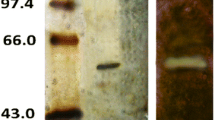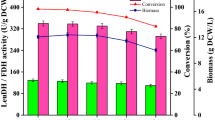Abstract
Production of an extracellular lipase from Serratia marcescens ECU1010, which is an industrially important biocatalyst for the stereospecific synthesis of Diltiazem precusor, was carefully optimized in both shake flasks and a fermenter, using Tween-80 as the enzyme inducer. Dextrin and beef extract combined with ammonium sulfate were indicated to be the best carbon and nitrogen sources, respectively. With the increase of Tween-80 from 0 to 10 g l−1, the lipase production was greatly enhanced from merely 250 U l−1 to a maximum of 3,340 U l−1, giving the highest lipase yield of ca 640 U g−1 dry cell mass (DCW), although the maximum biomass (6.0 g DCW l−1) was achieved at 15 g l−1 of Tween-80. When the medium loading in shake flasks was reduced from 20 to 10% (v / v), the lipase production was significantly enhanced. The increase in shaking speed also resulted in an improvement of the lipase production, although the cell growth was slightly repressed, suggesting that the increase of dissolved oxygen (DO) concentration contributed to the enhancements of lipase yield. When the lipase fermentation was carried out in a 5-l fermenter, the lipase production reached a new maximum of 11,060 U l−1 by simply raising the aeration rate from 0.5 to 1.0 vvm, while keeping the dissolved oxygen above 20% saturation via intermittent adjustment of the agitation speed (≥400 rpm), in the presence of a relatively low concentration (2 g l−1) of Tween-80 to prevent a potential foaming problem, which is easy to occur in the intensively aerated fermenter.




Similar content being viewed by others
Reference
Jaeger, K. E., Ransac, S., Dijkstra, B. W., Colson, C., Heuvel, M., & Misset, O. (1994). FEMS Microbiology Reviews, 15, 29–36.
Jaeger, K. E., Schneidinger, B., Rosenau, F., Werner, M., Lang, D., Dijkstra, B. W., et al. (1997). Journal of Molecular Catalysis. B, Enzymatic, 3, 3–12.
Reetz, M. T. (2002). Current Opinion in Biotechnology, 6, 145–150.
Muralidhar, R. V., Marchant, R., & Nigam, P. (2001). Journal of Chemical Technology & Biotechnology, 76, 3–8.
Koeller, K. M., & Wong, C. H. (2001). Nature, 409, 232–240.
Schmid, A., Dordick, J. S., Hauer, B., Kiener, A., Wubbolts, M., & Witholt, B. (2001). Nature, 409, 258–268.
Klibanov, A. M. (2001). Nature, 409, 241–246.
Shibatani, T., & Nakamichi, K. (1990). European Patent Application 362 556.
Dodds, D. R., & Lopez, J. L. (1993). US Patent 5 274 300.
Matsumae, H., Furui, M., & Shibatani, T. (1993). Journal of Fermentation and Bioengineering, 75, 93–98.
Matsumae, H., Furui, M., Shibatani, T., & Tosa, T. (1994). Journal of Fermentation and Bioengineering, 78, 59–63.
Gao, L., Xu, J. H., Li, X. J., & Liu, Z. Z. (2004). Journal of Industrial Microbiology & Biotechnology, 31, 525–530.
Dalmau, E., Montesinos, J. L., Lotti, M., & Casas, C. (2001). Enzyme and Microbial Technology, 26, 657–663.
Li, C. Y., Cheng, C. Y., & Chen, T. L. (2001). Enzyme and Microbial Technology, 29, 258–263.
Li, X. Y., Tetling, S., Winkler, U. K., Jaeger, K. E., & Benedik, M. J. (1995). Applied and Environmental Microbiology, 61, 2674–2680.
Gupta, R., Gupta, N., & Rathi, P. (2004). Applied Microbiology and Biotechnology, 64, 763–781.
Giuseppin, M. L. F. (1984). Applied Microbiology and Biotechnology, 20, 161–165.
Frost, G. M., & Moss, D. A. (1987). In H. J. Rehm & G. Reed (Eds.), Biotechnology, Vol 7a (pp. 65–211). Weinheim, Germany: VCH Verlag.
Chen, J. Y., Wen, C. M., & Chen, T. L. (1999). Biotechnology and Bioengineering, 62, 311–316.
Acknowledgement
This research was financially supported by the National Natural Science Foundation of China (Nos. 20272013, 20506037, and 203900506), Ministry of Science and Technology, People’s Republic of China (No. 2003CB716008) and the Science Commission of Shanghai Municipal Government (No. 05DZ19350).
Author information
Authors and Affiliations
Corresponding author
Rights and permissions
About this article
Cite this article
Long, ZD., Xu, JH. & Pan, J. Significant Improvement of Serratia marcescens Lipase Fermentation, by Optimizing Medium, Induction, and Oxygen Supply. Appl Biochem Biotechnol 142, 148–157 (2007). https://doi.org/10.1007/s12010-007-0023-6
Received:
Revised:
Accepted:
Published:
Issue Date:
DOI: https://doi.org/10.1007/s12010-007-0023-6




